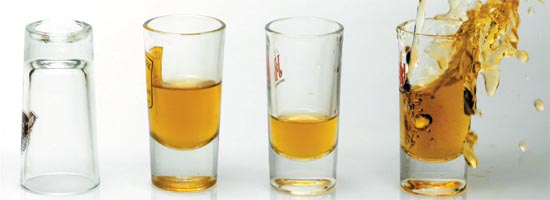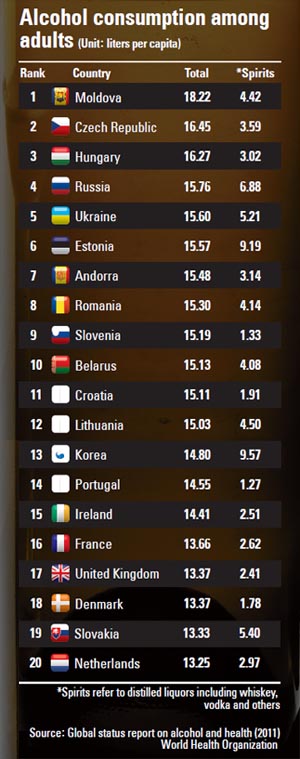Whiskey producers aim to make bigger splash

A typical night at a room salon, a drinking establishment where beautiful young female entertainers tend to ply groups of salary men with drinks amid some karaoke and intimacy, usually involves several bottles of whiskey and a bowl of fruit.
This culture of drinking by the bottle, and a tradition of consuming strong liquor to relieve stress, bond with work mates or forge business deals partly explains the booming sales of whiskey, known for its strong, smoky aroma, in Korea.
“When you need to build bonds with your clients to forge strong business relationships, you must have some drinks with them,” said a 52-year jewelry importer surnamed Kim.
“Imbibing together at bars, restaurants and room salons also helps win business deals that you may not have clinched otherwise, such as by giving a presentation in a meeting room.”
He added, “At bars and room salons you can discuss less formal topics in a relaxed atmosphere. You get to know your client, not just as your business partner, but as a person.”
Though whiskey consumption by volume has been slowly edging down in Korea since 2008, the country ranked as the world’s sixth-largest importer of the beverage in the first half of this year, according to statistics by the Scotch Whiskey Association. In the six-month period, whiskey imports stood at 65.8 million British pounds ($105 million).
Industry sources said Korea is an important market for liquor titans due to its unique drinking culture - with a predilection for boilermakers and so-called “love shots” - born with the country’s rapid economic development.

With the domestic whiskey market estimated to be worth 1.3 trillion won ($1.2 billion), it is no surprise that the world’s two biggest suppliers of spirits, UK drinks giant Diageo and French spirits group Pernod Ricard, have been waging a series of wars to gain a stronger foothold in this booze-loving country.
“Korea is the seventh-largest Scotch whiskey market for Diageo Korea and it is one of our fastest-growing markets,” said Jang Won-woo, public relations official at Diageo Korea. “We plan to widen our liquor portfolio to cater to consumers’ varied tastes.”
He added, “Foreign executives at Diageo Korea and Diageo headquarters are amused by Korea’s drinking culture. This has even led us to create a video helping overseas executives to understand Korea’s unique drinking culture, including “poktanju” [boilermakers, or ‘bomb shots’ in Korean].”
According to statistics by the Korea Alcohol & Liquor Industry Association, Diageo Korea’s share of the whiskey market stood at 37.3 percent last year, followed by Pernod Ricard Korea (33.3 percent) and Lotte Chilsung Beverage (16.2 percent).
Sophie Son, a spokesman for Pernod Ricard Korea, named the country as being among the producer’s top 10 markets.
While whiskey, a distilled liquor made from fermented grain mash, originated in Scotland and Ireland, it is now produced in the U.S., Canada and Japan, among other countries. To qualify as the real deal, it must have an alcohol content of at least 40 percent (80-proof), according to the Scotch Whiskey Association, which represents Scottish distillers.
Asia’s best boozers
The World Health Organization has found that Koreans drink more alcohol than any of their Asian neighbors. According to a report the WHO released in February on the annual per capita consumption of alcohol by country, Koreans each consume an average of 14.8 liters a year to rank 13th in the world and No. 1 in Asia. The results were based on data gathered from 2003 to 2005. The WHO said the average rate of consumption worldwide was 6.1 liters per person.
But when it comes to spirits alone, Koreans are world-beaters, with an average of 9.57 liters consumed per person every year, the data showed.
Suppliers are also buoyed by seeing global demand withstand the pounding dealt on many business sectors by the global economic turmoil. The Scotch Whiskey Association said worldwide shipments of Scotch whiskey rose 22 percent in the first half to 1.8 billion pounds.
Of this, the U.S. gobbled up the highest amount of 268 million pounds, followed by France with 219.5 million pounds. Korea ranks No. 6, or No. 3 in Asia after Singapore and Taiwan, having spent 65.8 million pounds on bringing shipments into the country in the first half.
For the whole of 2010, the world market for Scotch whiskey amounted to 3.45 billion pounds, of which Korea imported 153 million pounds worth.
Imperial versus Windsor

One of the biggest success stories was Imperial, which Pernod Ricard launched as a premium brand in 1994 to bolster its lineup that also includes Ballantine’s whiskey and Absolut vodka. The key difference with Imperial was that it had been engineered specifically to local tastes to challenge a market dominated by whiskies favored overseas.
“Imperial became the first whiskey brand in Korea to surpass 200 million bottles in combined sales in March,” said Son of Pernod Ricard Korea.
Producers also made a key change in terms of packaging: whereas whiskey is usually packaged in 375 milliliter and 750 milliliter bottles, Imperial was the first brand released worldwide in a 500 milliliter bottle.
Son said this size is a perfect fit for Korea, where groups of three or four people usually get together to drink. “In this sense, the smaller bottle doesn’t quite cut it and the 750 milliliter bottle is too much.”
As the brand defied critics who warned it would never take off because Koreans like to follow foreign trends and tastes, it was followed two years later by Diageo Korea’s new offering, Windsor.
Now the two trade sales advantages in the three key segments of 12-year, 17-year and 21-year whiskies, with Imperial traditionally dominating the first segment and Windsor the second. However, Windsor titled the balance in its favor last year by gaining a stranglehold in both.
Vowing to bounce back, Pernod Ricard Korea relaunched its Imperial 12 and 17 with different labeling and a focus on a new and smoother taste.
“We’ve lost leadership in terms of 12-year-old whiskies, but we haven’t lost the war - far from it,” said a defiant Jean-Manuel Spriet, CEO of Pernod Ricard Korea, at the relaunching ceremony.
Now both companies are dreaming up marketing strategies targeting employees at karaoke bars and room salons as these businesses account for 70 percent of annual whiskey consumption, industry sources said. Of this amount, they said 40 percent is consumed at year-end parties and gatherings attended by salaried workers.
Benjamin Farlow, Diageo Korea’s marketing director, claims the proportion is even more skewed here in favor of public drinking, with only 10 percent of the whiskey purchased in the country drunk at home.
To capitalize on this, Diageo Korea and Pernod Ricard Korea regularly hold football matches, golf tournaments and other events for employees at room salons and karaoke bars to build stronger bonds. Industry sources said this is one of the best ways to generate profits.
“Most customers who frequent these places don’t have any specific preference when it comes to whiskey,” said one insider, speaking on condition of anonymity. “They usually ask the proprietor or staff what they recommend. As such, room salon madams wield a great deal of influence and it pays for producers to curry favor with them.”
Ballantine’s vs. Johnnie Walker
Aside from Imperial and Windsor, the two liquor giants’ global flagship whiskey brands are Ballantine’s (Pernod Ricard) and Johnnie Walker (Diageo). These are the top two souvenirs brought back from overseas by Korean businessmen, industrial officials said.
Industry sources said Koreans make up over 70 percent of Ballantine’s annual sales because the company has so strongly ingrained itself on the public imagination as being synonymous with high-end whiskey. This includes bottles bought at duty free shops in airports.
Ballantine’s sells more than 72 million bottles a year and Johnnie Walker sells an average of 130 million bottles a year, the companies said.
A popular promotional tool for both is sponsoring golf tournaments, which Korean businessmen often use as a pretext to wine and dine clients. Many develop an interest in the game for fitness, bonding and career-advancement purposes.
“There’s a saying that Scotland’s biggest gifts to the world were whiskey and golf,” said Jang Won-woo of Diageo Korea. “Golf is the sport that best describes Johnnie Walker’s philosophy of ‘Keep Walking,’ which embraces personal progress, hard work and perseverance.”
The producer sponsorsthe Johnnie Walker Championship at Gleneagles in Europe. For the last three years, it has also attached its name to the Johnnie Walker Open on Jeju Island.
“If a Korean player wins [in Jeju], they automatically book their berth at the Johnnie Walker Championship,” said Jang. “So the tournament isn’t just an exercise in branding, but rather provides rising pros here with a chance at world-class competition.”
Meanwhile, Ballantine’s sponsors the Barclays Scottish Open as well as the Ballantine’s Championship in Korea, which in 2008 became the first European Tour-sanctioned event in the country.
“Ballatine’s and golf both originated from Scotland,” said Son, quickly adding, “The purpose of the tournament is to promote Korea as a golfing powerhouse to the world.”
By Kim Mi-ju [mijukim@joongang.co.kr]










with the Korea JoongAng Daily
To write comments, please log in to one of the accounts.
Standards Board Policy (0/250자)